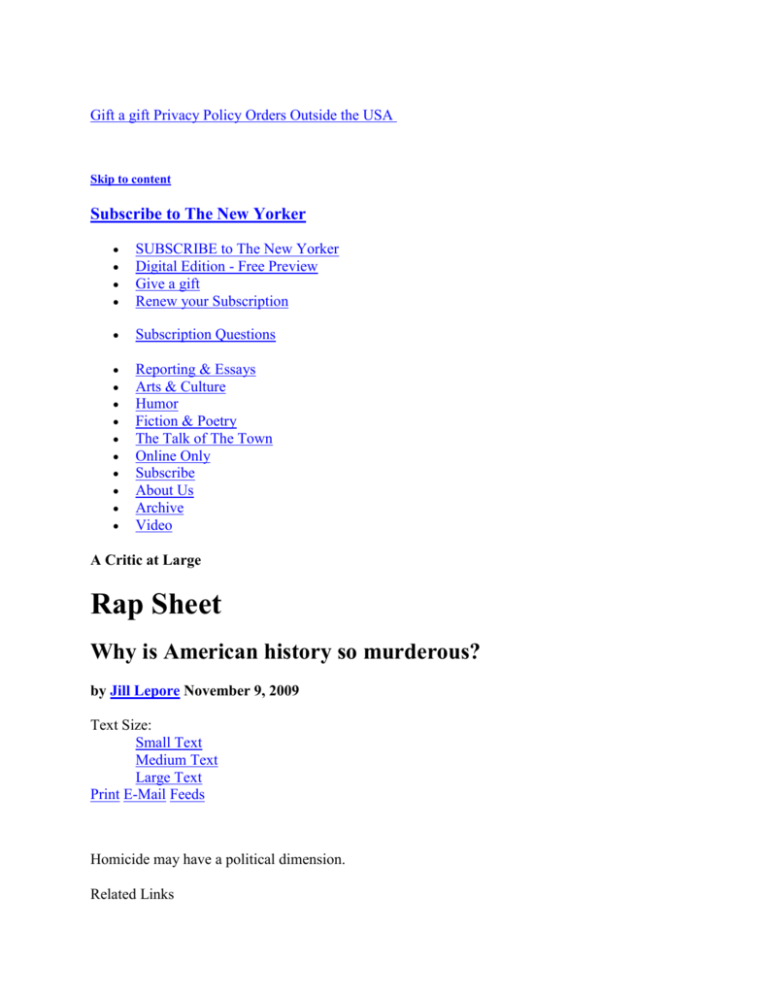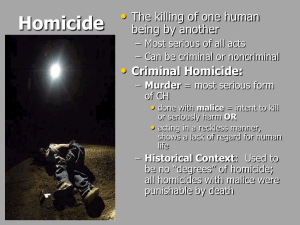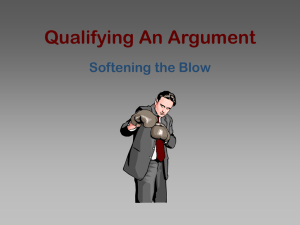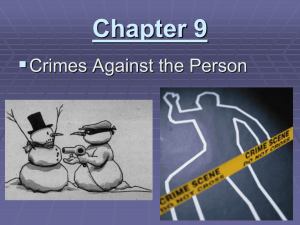
Gift a gift Privacy Policy Orders Outside the USA
Skip to content
Subscribe to The New Yorker
SUBSCRIBE to The New Yorker
Digital Edition - Free Preview
Give a gift
Renew your Subscription
Subscription Questions
Reporting & Essays
Arts & Culture
Humor
Fiction & Poetry
The Talk of The Town
Online Only
Subscribe
About Us
Archive
Video
A Critic at Large
Rap Sheet
Why is American history so murderous?
by Jill Lepore November 9, 2009
Text Size:
Small Text
Medium Text
Large Text
Print E-Mail Feeds
Homicide may have a political dimension.
Related Links
The Book Bench: Lepore on The New Yorker’s least compassionate true-crime writer.
Keywords
Murder;
Death Penalty;
Randolph Roth;
“American Homicide” (Harvard; $45);
“A History of Murder: Personal Violence in Europe from the Middle Ages to the Present”
(Polity; $24.95);
Pieter Spierenburg;
Eric Monkkonen
Steven Hayes and Joshua Komisarjevsky, who met three years ago in a Hartford drug-treatment
center and shared a room in a halfway house in between stints in prison, were both seasoned
burglars, though Hayes, a forty-four-year-old crack addict, was quite a bit older than
Komisarjevsky, who was twenty-six, and the great-grandson of a Russian princess. In the spring
of 2007, both men were paroled. Hayes, whose arrest record stretches back to 1980, had served
about three years of a five-year sentence for third-degree burglary, and Komisarjevsky had
finished half of a nine-year sentence for burglary in the second degree. Hayes moved in with his
mother, in Winsted, in Litchfield County; Komisarjevsky went back to his home town, Cheshire,
a suburb about fifteen miles north of New Haven. They kept in touch. On July 23, 2007,
authorities say, Hayes and Komisarjevsky broke into the Cheshire home of William Petit, Jr., an
endocrinologist, and tortured the family through the night, raping Petit’s wife, Jennifer HawkePetit, and at least one of the couple’s two daughters. In the morning, Hayes and Komisarjevsky
are said to have forced Hawke-Petit, a school nurse who suffered from multiple sclerosis, into
the family car and taken her to a local bank, where she withdrew fifteen thousand dollars, after
which a suspicious teller alerted the police. The two men allegedly then took Hawke-Petit back
to the house, killed her, set the house on fire, and fled in the Petits’ S.U.V., though not far: they
crashed into a police barricade, just past the driveway.
Inside the house, a four-bedroom Colonial, police found three bodies. Hawke-Petit, forty-eight,
had been strangled. Seventeen-year-old Hayley Petit, who, that September, was to start college at
Dartmouth, died of smoke inhalation. Her eleven-year-old sister, Michaela, was found tied to a
bed, her body badly burned after having been doused with gasoline. Only William Petit, who had
been bound with rope, beaten in the head with a baseball bat, and left for dead in the cellar,
survived.
Hayes and Komisarjevsky have been charged with kidnapping, sexual assault, arson, and murder.
Jury selection for Hayes’s trial is scheduled to begin in January, in New Haven. William Petit,
who is expected to testify about what happened that night, had asked not to be put through that
ordeal twice, but his request for a single trial was denied. A trial date for Komisarjevsky has not
yet been set. The state is seeking the death penalty.
Every murder raises terrible questions that no trial, no law, no punishment can answer. What
forces make it possible for one human being to take the life of another? Murders can be solved
and even explained—at least, that’s the operating assumption of criminal investigation and the
narrative logic behind every whodunit—but to think about a specific murder with any clarity, or
for very long, can be difficult, and viscerally painful. Maybe the brisk trade in lurid violence as
spectacle has something to do with it: one either watches or averts one’s eyes; dispassionate
reflection rarely enters into it. Scholars ranging from theologians and psychologists to
evolutionary biologists have offered theories about murder—theories of evil, theories of disease,
theories of disposition—but the analytical burden placed on any general discussion of murder,
freighted, as it is, with atrocity, is nearly unbearable. Nothing suffices, or can.
Between the convulsive emotional response to a single murder and an elusive general theory of
murder lies another kind of contemplation: the study of the murderousness of nations. The
United States has the highest homicide rate of any affluent democracy, nearly four times that of
France and the United Kingdom, and six times that of Germany. Why? Historians haven’t often
asked this question. Even historians who like to try to solve cold cases usually cede to
sociologists and other social scientists the study of what makes murder rates rise and fall, or what
might account for why one country is more murderous than another. Only in the nineteenseventies did historians begin studying homicide in any systematic way. In the United States, that
effort was led by Eric Monkkonen, who died in 2005, his promising work unfinished.
Monkkonen’s research has been taken up by Randolph Roth, whose book “American Homicide”
(Harvard; $45) offers a vast investigation of murder, in the aggregate, and over time. Roth’s
argument is profoundly unsettling. There is and always has been, he claims, an American way of
murder. It is the price of our politics.
In the archives, murders are easier to count than other crimes. Rapes go unreported, thefts can be
hidden, adultery isn’t necessarily actionable, but murder will nearly always out. Murders enter
the historical record through coroners’ inquests, court transcripts, parish ledgers, and even
tombstones. “Fell by the hands of William Beadle / an infatuated Man who closed the / horrid
sacrifice of his Wife / & Children with his own destruction,” reads the headstone of Lydia
Beadle, of Wethersfield, Connecticut, who was murdered, along with her two children, in 1782.
The number of uncounted murders, known as the “dark figure,” is thought to be quite small.
Given enough archival research, historians can conceivably count, with fair accuracy, the
frequency with which people of earlier eras killed one another, with this caveat: the farther back
you go in time—and the documentary trail doesn’t go back much farther than 1300—the more
fragmentary the record and the bigger the dark figure.
Pieter Spierenburg, a professor of historical criminology at Erasmus University, in Rotterdam,
sifts through the evidence in “A History of Murder: Personal Violence in Europe from the
Middle Ages to the Present” (Polity; $24.95). In Europe, homicide rates, conventionally
represented as the number of murder victims per hundred thousand people in the population per
year, have been falling for centuries. Spierenburg attributes this long decline to what the German
sociologist Norbert Elias called the “civilizing process” (shorthand for a whole class of behaviors
requiring physical restraint and self-control, right down to using a fork instead of eating with
your hands or stabbing at your food with a knife), and to the growing power of the centralizing
state to disarm civilians, control violence, enforce law and order, and, broadly, to hold a
monopoly on the use of force. (Anthropologists sometimes talk about a related process, the
replacement of a culture of honor with a culture of dignity.) In feuding medieval Europe, the
murder rate hovered around thirty-five. Duels replaced feuds. Duels are more mannered; they
also have a lower body count. By 1500, the murder rate in Western Europe had fallen to about
twenty. Courts had replaced duels. By 1700, the murder rate had dropped to five. Today, that rate
is generally well below two, where it has held steady, with minor fluctuations, for the past
century.
In the United States, the picture could hardly be more different. The American homicide rate has
been higher than Europe’s from the start, and higher at just about every stage since. It has also
fluctuated, sometimes wildly. During the Colonial period, the homicide rate fell, but in the
nineteenth century, while Europe’s kept sinking, the U.S. rate went up and up. In the twentieth
century, the rate in the United States dropped to about five during the years following the Second
World War, but then rose, reaching about eleven in 1991. It has since fallen once again, to just
above five, a rate that is, nevertheless, twice that of any other affluent democracy.
What accounts for this remarkable difference? Guns leap to mind: in 2008, firearms were
involved in two-thirds of all murders in the United States. Yet Roth, who supports gun control,
insists that the prevalence of guns in America, and our lax gun laws, can’t account for the whole
spread, and a few scholars have argued that laws allowing concealed weapons actually lower the
murder rate, by deterring assaults. Some Europeans suspect that Americans haven’t undergone
the same “civilizing process,” as if, unmoored from Europe, Colonial Americans went
murderously adrift. Spierenburg speculates that democracy came too soon to the United States.
By the time European states became democracies, the populace had accepted the authority of the
state. But the American Revolution happened before Americans had got used to the idea of a
state monopoly on force. Americans therefore preserved for themselves not only the right to bear
arms—rather than yielding that right to a strong central government—but also medieval
manners: impulsiveness, crudeness, and fidelity to a culture of honor. We’re backward, in other
words, because we became free before we learned how to control ourselves.
Perhaps unsurprisingly, not everyone buys these arguments, and Monkkonen himself took a
different, though equally conjectural, approach. At the time of his death, he had been working on
an article called “Homicide: Explaining America’s Exceptionalism,” which hypothesized that
four factors accounted for the centuries-long differences between American and European
homicide rates: mobility, federalism, slavery, and tolerance. Mobility breaks social ties;
federalism is a weak form of government; slavery not only rationalized a culture of violence
among white Southerners (where the murder rate has been disproportionately high, as it has, and
remains, in many of the so-called law-and-order states) but also infected American culture; and
American judges and juries have historically proved less willing than their European
counterparts to convict murderers, tolerating, among other crimes, racial murders and killings by
jealous spouses.
Roth, who teaches at Ohio State, wants to bring into this debate hard facts and rigorous methods.
He rejects arguments about the “civilizing process” by pointing out that people didn’t necessarily
intend to murder one another more often in the premodern world; they merely succeeded more
often. Given modern medicine—emergency response, trauma surgery, antibiotics, and wound
care—three out of every four people murdered before 1850 would probably survive today. Roth
heads a collaborative project, dedicated to Monkkonen, called the Historical Violence Database,
which has assembled reports of murders in several of the original thirteen colonies; nineteenthcentury records from five states, seven cities, and thirty-four counties; and a wealth of twentieth-
century statistics, chiefly from the Uniform Crime Reports kept by the F.B.I. beginning in 1930.
As a discussion of the available data, “American Homicide” is rich, fascinating, and unrivalled.
As an explanation, though, it gets dubious. Roth’s work involves three steps: first, he uses his
database to count murders (he’s primarily interested in homicides among unrelated adults); then,
using surviving censuses to count people, he calculates the homicide rate; finally, he attempts to
explain what factors correlate with that rate, across four centuries. It’s the last step that’s the
most wobbly.
Historians haven’t studied murder much, but criminologists have. Although most criminologists
trace the homicide rate back only a few decades, Roth takes his lead from their work. The
fluctuations in the homicide rate since the nineteen-forties have at least something to do with
demography. A vastly disproportionate number of murderers and murder victims are young adult
men. When baby boomers reached that age bracket, the homicide rate soared. Now that they’ve
aged out of their most lethal years, the rate has fallen. To Roth, the demographic explanation of
the postwar crime boom and bust falls short, but, where other social scientists have investigated
economic conditions like joblessness or government policies like gun control to fill the
explanatory gap, Roth favors the argument made by a criminologist named Gary LaFree, in a
book called “Losing Legitimacy: Street Crime and the Decline of Social Institutions in America”
(1998). LaFree observed that the crime rate correlates, inversely, with public faith in government
and trust in elected officials. So, for instance, the Vietnam era, marked by declining confidence
in elected officials, experienced a rising crime rate. He measured that faith and trust by
consulting national opinion surveys taken beginning in 1958, which asked questions like “How
much of the time can you trust the government to do what is right?”
Roth attempts to graft LaFree’s argument onto all of American history. He has determined that
four factors correlate with the homicide rate: faith that government is stable and capable of
enforcing just laws; trust in the integrity of legitimately elected officials; solidarity among social
groups based on race, religion, or political affiliation; and confidence that the social hierarchy
allows for respect to be earned without recourse to violence. When and where people hold these
sentiments, the homicide rate is low; when and where they don’t, it’s high.
Whatever you think about the value of public-opinion polls, LaFree at least had them. Roth
doesn’t. How do you measure the belief that government is stable in 1695 or 1786 or 1814 or
1902? You can’t. You can only look at what was happening in those years and tell a story about
what you think people believed about their government, and, if you know what the homicide rate
is, it’s easy to find a story that fits your data. The homicide rate in New England fell from a high,
in 1637, of a hundred and twenty to under one, in 1800, chiefly by dropping, rather dramatically,
after the Pequot War and King Philip’s War. Roth argues that the rate fell, over all, as judicial
institutions were established and people developed faith in them, and that the rate fell, sharply,
after these wars because conflicts with hostile neighbors brought the colonists together. But it
seems equally plausible to argue that the homicide rate in Colonial New England tracks the
European decline quite nicely, over all, and drops, in a stepwise fashion, after wars because they
diminish the population of young men, leaving fewer potential murderers and murder victims
around. Both interpretations make sense; neither has been demonstrated.
The implications of Roth’s argument are, as he realizes, distressing. Democracy requires dissent.
If a high American murder rate is a function of not placing our trust in government, are we
doomed to endure a high murder rate? Roth takes his case all the way to the White House: “The
statistics make it clear that in the twentieth century, homicide rates have fallen during the terms
of presidents who have inspired the poor or have governed from the center with a popular
mandate, and they have risen during the terms of presidents who presided over political and
economic crises, abused their power, or engaged in unpopular wars.” The homicide rate appears
to correlate with Presidential approval ratings. If Roth is right, electing a bad President is
dangerous and inciting people to hate any President, good or bad, could be deadly. But which is
the cart, and which the horse? The Presidential approval rate might be a proxy for all sorts of
measures of a well or poorly adjusted society. Or maybe there’s another horse, somewhere, some
third factor, that determines both the Presidential approval rate and the homicide rate. It’s hard to
say, partly because, in using quantitative methods to make an argument about the human
condition, Roth has wandered into a no man’s land between the social sciences and the
humanities. After a while, arguments made in that no man’s land tend to devolve into
meaninglessness: good government is good, bad government is bad, and everything’s better
when everything’s better. Correlating murder with a lack of faith and trust may contain its
horror, but only because, in a bar graph, atrocity yields to banality.
Every September, the F.B.I. issues a report on crime, a compilation of statistics for the previous
year. It does not offer an interpretation of this immense quantity of data. “We leave that up to the
academics and the criminologists and the sociologists,” an F.B.I. spokesman said, upon the
release of this year’s report. For all the number crunching, it’s clear that there is no such thing as
an average murder. Even if there were, what happened at the Petits’ house in Cheshire,
Connecticut, on July 23, 2007, wouldn’t be it, and not just because of that crime’s particular
depravity. Much about the case is out of the ordinary. The victims were white and wealthy;
murder victims are disproportionately black and poor. Exceptional, high-profile crimes often
lead to legislative action driven by citizen initiative. California’s controversial three-strikes law,
a ballot measure, was proposed by a Fresno photographer whose daughter was murdered. Last
year, after the Petit murders, the Connecticut legislature doubled and tripled mandatory penalties
for second- and third-time offenders. “Big cases make bad laws” is a criminological axiom, and
one with which Mark A. R. Kleiman agrees, in “When Brute Force Fails: How to Have Less
Crime and Less Punishment” (Current Affairs; $29.95). Kleiman blames big cases and bad laws
for another distinctive feature of American life: 2.3 million people are currently behind bars in
the United States. That works out to nearly one in every hundred adults, the highest rate
anywhere in the world, and four times the world average. Prison crowding may have been one
reason that Steven Hayes and Joshua Komisarjevsky were paroled. Although the crime rate today
is fifteen per cent lower than it was twenty-five years ago, the incarceration rate is four times as
high. At what point, Kleiman wonders, will incarceration be a greater social ill than crime? He
proposes, for lesser offenders, punishments that are swift and certain but not necessarily severe: a
night in jail, instead of a warning, for missing a meeting with a parole officer, say, and ten nights
the next time. Whether or not Kleiman’s recommendations are practical, Connecticut, reeling
from the Petit murders, is heading in the opposite direction.
The F.B.I. may leave the analysis of crime to academics, but, in the past few decades, the
government has, increasingly, left the punishment of criminals up to public opinion. William
Petit and his sister-in-law Johanna Petit-Chapman serve as the honorary co-chairs of Three
Strikes Now, a grass-roots organization lobbying the state legislature to adopt California-style
mandatory sentencing of life without the possibility of parole for third-time violent offenders.
The Cheshire case has also dominated the state’s death-penalty debate, a debate that, nationwide,
has long centered on race. In Connecticut, whose population is eighty-four per cent white, six of
the ten men on death row are black. (Both Hayes and Komisarjevsky are white.) Earlier this year,
the Connecticut legislature voted to abolish the death penalty. William Petit publicly denounced
the bill, and Jodi Rell, the state’s governor, a Republican, vetoed it.
Capital punishment has been on the books in Connecticut since 1642. Three strikes has been
tried before, too. In Colonial America, many crimes, including murder, were punishable by death
and, for lesser crimes, Connecticut, like many colonies, mandated the death penalty for thirdtime offenders. That began to change on September 7, 1768, when a burglar named Isaac Frasier
was hanged in Fairfield. Frasier had shown early evidence of a “thievish Disposition.” “Men go
from one degree of wickedness to another,” the town’s minister said in a sermon at the gallows
titled “Excessive Wickedness, the Way to an untimely Death.” Convicted of burglary in New
Haven, Frasier was whipped and branded and had his ears cropped. Caught again in Fairfield in
1766, he received the same punishment “and was solemnly warned . . . that death would be his
punishment on a third Conviction.” When Frasier robbed another house, he was sentenced to
death. “The Government of Connecticut have always been remarkably tender of putting persons
to Death,” one observer noted. But when Frasier applied to the legislature for clemency, he was
denied. Said the pastor at the gallows, “Justice requires that you should suffer.”
An outcry followed. Two weeks after Frasier’s death, a Hartford newspaper published an essay
called “An Answer to a very important Question, viz. Whether any community has a right to
punish any species of theft with death?” The writer’s answer—an emphatic no—borrowed
extensively from Cesare Beccaria’s treatise “On Crimes and Punishments,” published in 1764.
Beccaria, an Italian nobleman, argued against capital punishment—which was, at the time,
widespread in Europe, too—on two grounds: first, in a republic men do not forfeit their lives to
the government; and, second, capital punishment does not deter crime. Beccaria argued (and
Kleiman has merely revisited that argument) that punishments, to be effective, must be swift and
certain but not necessarily severe. Punishments, he insisted, should be proportionate to crimes,
whose dangerousness could be measured, in “degrees,” by their injury to society. For the crime
of murder, Beccaria considered life in prison to be both more just and a more effective deterrent
than execution.
The first American edition of Beccaria’s treatise was published in 1777, and it reached a wide
audience in Connecticut beginning in 1786, when it was serialized in a New Haven newspaper.
“If we glance at the pages of history, we will find that laws, which surely are, or ought to be,
compacts of free men, have been, for the most part, a mere tool for the passions of some,”
Beccaria wrote. This argument held particular appeal for a people who had just finished waging a
war against the passions of King George; adopting Beccaria’s recommendations came to seem,
in a fundamental sense, American, as if the United States had a special role to play, as a republic,
in the abolition of capital punishment. In 1784, the Yale senior class debated whether the death
penalty was “too severe & rigorous in the United States for the present Stage of Society.”
In the seventeen-nineties, five states abolished the death penalty for all crimes except murder. By
the eighteen-twenties, all Northern states reserved capital punishment for first-degree murder.
When incarceration replaced all corporal and most capital punishment, Americans built prisons,
and sentenced criminals to jail time. In 1846, Michigan became the first state to abolish the death
penalty. Twice, in the middle of the nineteenth century, the governor of Connecticut asked the
state’s legislature to do the same, to no avail.
In the course of the twentieth century, capital punishment was abolished in much of the world,
including all of Western Europe, but not in the United States. Germany, Austria, and Italy
stopped executing criminals after the Second World War. Beginning in the nineteen-fifties, other
European countries began limiting capital punishment. Denmark abolished it entirely in 1978;
the Netherlands, Australia, and New Zealand in the nineteen-eighties; Britain, Canada, and
Belgium in the nineteen-nineties. In many parts of the United States, the death penalty was, if not
outlawed, abandoned. Except for a serial murderer named Michael Ross, who was killed by
lethal injection in 2005, after he waived his right to appeal because he wanted to die, no one has
been executed in Connecticut, or anywhere else in New England, since 1960.
Not so elsewhere. Since 1976, more than a thousand people have been executed in the United
States, a third of them in Texas. If Hayes and Komisarjevsky are found guilty and sentenced to
death instead of life in prison without the possibility of parole, they will be killed by lethal
injection. China, Iran, and Saudi Arabia execute more criminals, but, among affluent
democracies, the death penalty, like the U.S. homicide and incarceration rates, marks an
American exception, or, looked at another way, an anachronism.
Long ago, Beccaria pointed out the meaningfulness of the correspondence, over time, between
crime and punishment, between one kind of violence and another. If the history of murder
contains a lesson, Beccaria believed, it was this: “The countries and times most notorious for
severity of punishment have always been those in which the bloodiest and most inhumane of
deeds were committed.”
Murder has a history, but it isn’t always edifying, and sometimes the history of crime and
punishment has a chilling sameness. The prospect of death didn’t deter Barnett Davenport, a
Connecticut murderer who was hanged in 1780, at the age of nineteen. “No man becomes a devil
in a minute,” Davenport said, in a confession made a week before he mounted the gallows. His
life of crime began when, at the age of twelve, he stole some watermelons from a neighbor’s
garden. More than once, he was caught. But by the time he was eighteen he had advanced from
pilfering eggs and potatoes to stealing horses. He fought in the Revolution and then deserted. He
went to live in the house of a man named Caleb Mallery, near Litchfield. On February 3, 1780,
“a night big with uncommon horror” (and a year with an elevated homicide rate), Davenport
killed Mallery, Mallery’s wife, and their seven-year-old granddaughter, beating their heads in
with a pestle and a rifle. Next, he pried open the family’s money chest and took from it a pile of
bills and a handful of coins. Then he set the house on fire, leaving inside two more children, ages
six and four. He was captured, and swiftly hanged. In his confession, he recalled that Caleb
Mallery had cried out, in between blows, “Tell me what you do it for!” History does not record
the murderer’s reply. ♦
ILLUSTRATION: ANDERS WENNGREN
Print E-Mail Feeds
Share:
Digg
facebook
Yahoo! Buzz
More
To get more of The New Yorker's signature mix of politics, culture and the arts: Subscribe now
More In This Section
The Current Cinema: Making Peace by Anthony Lane
Books: Flesh of Your Flesh by Elizabeth Kolbert
Musical Events: Primal Song by Alex Ross
The Art World: Twentieth-Century Man by Peter Schjeldahl
The Current Cinema: Flights of Fancy by David Denby
Books: The Things People Say by Elizabeth Kolbert
The Theatre: Class Wars by John Lahr
The Theatre: Can’t Stop the Beat by John Lahr
A Critic at Large: Lucky Man by John Lahr
The Current Cinema: Trouble in Eden by Anthony Lane
View All
Cartoon Kit: Create your own cartoon; no drawing required.
ENTER NOW | VIEW ENTRIES
News Desk: Elizabeth Kolbert interviews Al Gore.
Hendrik Hertzberg makes election predictions.
Evan Osnos: The two lives of a Manhattan Project scientist.
Steve Coll: Abdullah Abdullah’s next move.
The Book Bench: A musical book club.
Close Read: The U.S.S. New York.
The Front Row: The sex scenes in “Antichrist.”
Alex Ross: Sandrine Piau sings Handel.
The Cartoon Lounge: Better than a smartphone.
Back Issues: Drunken newsmen.
George Packer argues with Antonin Scalia.
James Surowiecki: More on price wars.
John Cassidy: The government and the recovery.
Sasha Frere-Jones likes Kate Miller-Heidke.
New Yorker Festival: Atul Gawande.
SEE ALL BLOG POSTS
Now reading “War Dances,” by Sherman Alexie.
View the table of contents.
This week’s iPhone sketch by Jorge Colombo.
James Surowiecki speaks with the Nobel Prize-winning economist Joseph Stiglitz.
Browse the complete archive using the cover gallery.
Select a year
enter | vote | results
Gaza in Ruins: The violent conflict between Israel and Hamas.
The Political Scene: Hendrik Hertzberg and Ryan Lizza on Harry Reid’s public-option
gambit.
Drag and Drop: Robert Mankoff and Zachary Kanin talk about cartoons.
MORE PODCASTS
Perfectly Pounding: Freddie Gibbs, a cappella.
DVD of the Week: Richard Brody on Wes Anderson’s “The Darjeeling Limited.”
Behind the Cover: The artists for this week’s three covers discuss the concept with
Françoise Mouly, The New Yorker’s art editor.
Flashover: David Grann discusses the flaws of the Cameron Todd Willingham
investigation.
A True Believer: The collapse of North Korea’s food-distribution system.
An Academy of One: Arshile Gorky’s life and works.
Art Factory: Peter Hessler discusses Chinese artists for hire.
This Is Your Brain on Football: Malcolm Gladwell discusses the inherent danger of the
sport.
The New Yorker Festival returns, and more events involving New Yorker contributors.
newsletter sign-up
new sletter
shortForm
This Week
Links to articles and Web-only features, in your inbox every Monday.
handler.new sletter.217.
217
true
Cartoons
A weekly note from the New Yorker's cartoon editor.
handler.new sletter.442.
442
true
e-mail address
nonparsed
The New Yorker
o Arts & Culture
Welcome to The New Yorker Log in | Register
popular
most e-mailed
this issue
cartoons
1.
2.
3.
4.
5.
Gaza, Gilad Shalit, Hamas, and Israel
Football, dogfighting, and brain damage
Premium Harmony
Flesh of Your Flesh
Murder in America
1.
2.
3.
4.
5.
Gaza, Gilad Shalit, Hamas, and Israel
Football, dogfighting, and brain damage
Flesh of Your Flesh
Premium Harmony
The Amazon Wal-Mart price war
Lawrence Wright: What really happened during the Israeli attacks?
Hendrik Hertzberg: The imperial Bloomberg.
Stephen King: “Premium Harmony.”
Table of Contents for November 9, 2009.
Digital Edition: Browse this issue online.
Cartoon Kit: Make cartoon and enter a new contest.
Caption Contest: Submit, vote, and see winning entries.
Slide Show of cartoons from the current issue.
Video: Ten-second animations of classic cartoons.
The Cartoon Lounge: A blog by New Yorker cartoonists.
powered by
EDITORS’ CHOICE
Video: Meredith Monk’s “Songs of Ascension.”
Events & Promotions
RSS Feeds
Stay up to date on everything happening at newyorker.com.
See every page of the latest issue on Mondays.
Order your 2010 Desk Diary. Now available in seven vibrant colors.
Cartoon and cover art: prints, T-shirts, licensing, and other gifts.
Your connection to exclusive events and offers from The New Yorker promotion
department.
Subscribe to a weekly audio download of selected articles from the magazine.
Download the new New Yorker animated-cartoon app. Plus podcasts, video, and audio
issues at the iTunes music store.
The New Yorker on Facebook
Contact Us
Newsletter
Blogs
Archive
Press Center
RSS Feeds
Subscription Services
Careers
New Yorker Store
Reprints/Permissions
The New Yorker Media Kit
Condé Nast Digital
More news, politics, culture, business, and technology:
Vanity Fair
Wired
Subscribe to a magazine:
Subscribe to a magazine
Visit our sister sites:
Visit our sister sites
Registration on or use of this site constitutes acceptance of our User Agreement (Revised
January 7, 2009) and Privacy Policy (Revised January 7, 2009). The New Yorker © 2009 Condé
Nast Digital. All rights reserved. The material on this site may not be reproduced, distributed,
transmitted, cached or otherwise used, except with the prior written permission of Condé Nast
Digital.










